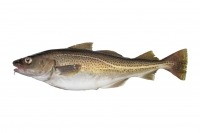
(Photo: Claude Nozères)
Atlantic Cod
Gadhus morhua
This fish has three dorsal fins, a prominent lateral line and a barbel under its chin. It is brown to greenish-grey on its back with a paler belly and often spotted. Adults are usually from 35 to 85 centimetres in length. The largest cod ever caught weighed 96 kilograms and was 180 centimetres long.
Authority
Linnaeus, 1758
Classification Details
Phylum: Chordata (chordates); Subphylum: Vertebrata (vertebrates); Class: Actinopterygii (ray-finned fishes).
Habitat
Atlantic cod inhabit waters on the continental shelves of the northeast and the northwest Atlantic Ocean. In Canada Atlantic cod are found from Baffin Island in the Arctic to Georges Bank and the Bay of Fundy. For the first one to four years of their life, juvenile cod favour coastal habitats such as eelgrass beds and cobble seabeds. These provide shelter from predators. Older cod may be found down to 600 metres but are usually at depths of around 150-200 metres. It is a demersal fish, spending most time close to the seabed. Individuals form large shoals. Some cod populations migrate to the coast to spawn.
Diet
Cod larvae feed on phytoplankton and small zooplankton. Juvenile cod eat small crustaceans. As soon as their mouth is big enough, they eat other fish such as herring, cunners, flounder, sculpins and even other cod. They will also eat squid, crab, molluscs, echinoderms and worms.
Reproduction
Sexes are separate. Female cod mature at between two and seven years of age. Cod are broadcast spawners, releasing many eggs and providing no parental care. Females produce between 300 000 to several million eggs per breeding season. The male cod grasps the female with his pelvic fins she releases her eggs, and then he releases sperm to fertilize them. The female may mate with several males. The female releases her fertilized eggs in batches over three to six weeks. After around two weeks they hatch. They stay in the plankton for several months before moving to seabed habitats. The eggs, larvae and juveniles are vulnerable to water currents and predators. Only about one egg per million will survive to become an adult. Adults can live for up to 25 years.
Fun Facts
Landlocked populations of cod live in coastal marine lakes on Baffin Island. These lakes only get seawater input on the very highest summer tides.
Male cod make a drumming sound by vibrating muscles against their air bladder. Scientists think females may choose their mates by the tone of this sound. Scientists have found that the tone relates to size and bigger males are likely to be more successful mates.
References
COSEWIC 2010. COSEWIC assessment and status report on the Atlantic Cod Gadhus morhua in Canada. Committee on the Status of Endangered Wildlife in Canada. Ottowa. Cohen DM, Inada T, Iwamoto T and Scialabba N (1990) Gadiform fishes of the world (Order Gadiformes): An annotated and illustrated catalogue of cods, hakes, grenadiers and other gadiform fishes known to date. FAO Species Catalogue Volume 10. FAO, Rome. 452 pp. Rowe S and Hutchings JA (2008) A link between sound producing musculature and mating success in Atlantic cod. Journal of Fish Biology 72, 500–511. Scott WB and Scott MG (1988) Atlantic fishes of Canada. Canadian Bulletin of Fisheries and Aquatic Sciences 219, 731p.

